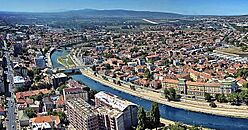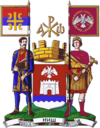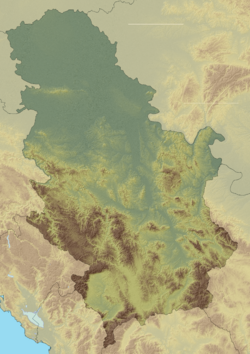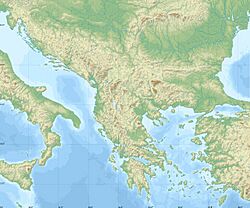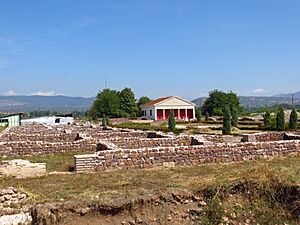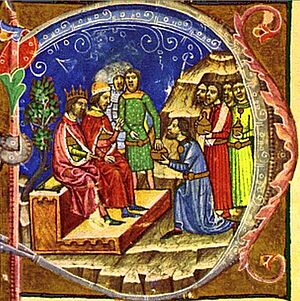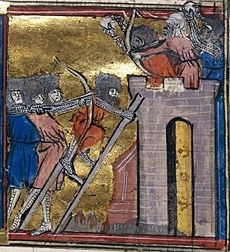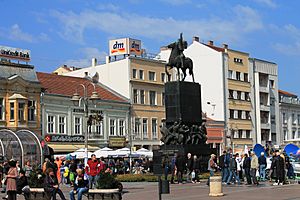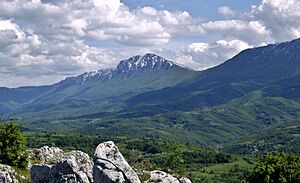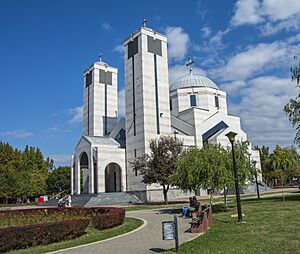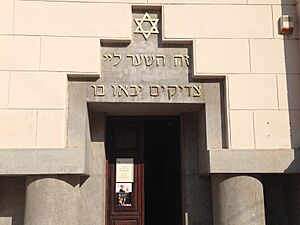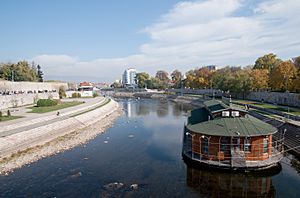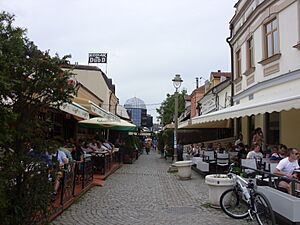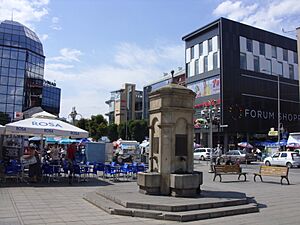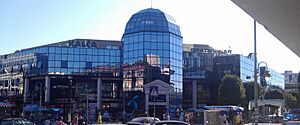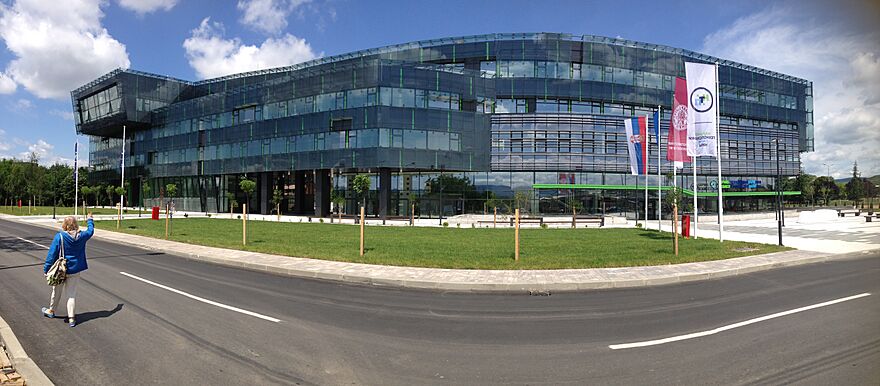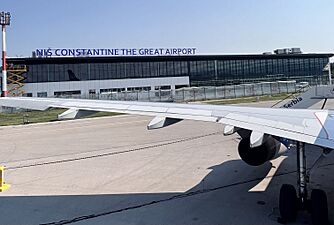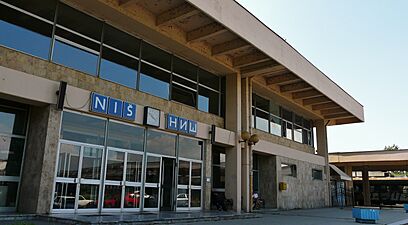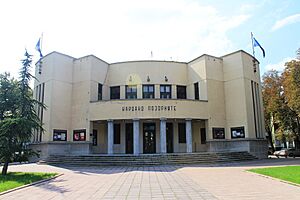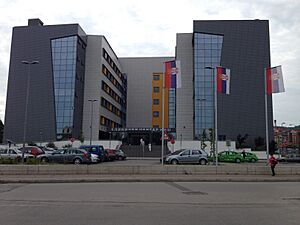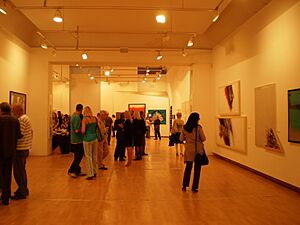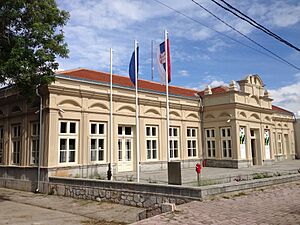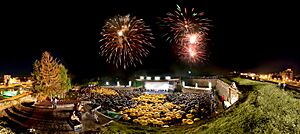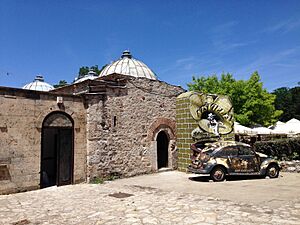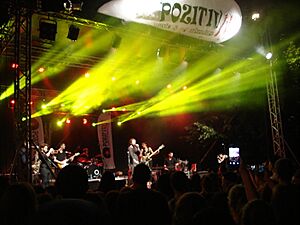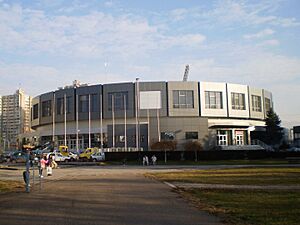Niš facts for kids
Quick facts for kids
Niš
Ниш (Serbian)
|
|||
|---|---|---|---|
| Град Ниш Grad Niš City of Niš |
|||
|
Panorama of Niš
Niš City Hall
Niš Fortress
Palace of Justice
Memorial Chapel
Bubanj Memorial Park
Monument on Čegar
Church of the Holy Emperor Constantine and Empress Helena
Nišava river
University of Niš
|
|||
|
|||
| Nickname(s):
"Second capital"
"Imperial City" |
|||
| Country | Serbia | ||
| Geographical Region | Southern Serbia | ||
| Statistical Region | Southern and Eastern | ||
| District | Nišava | ||
| Municipalities | 5 | ||
| First mention | 2nd century AD | ||
| Liberation from Ottomans | 11 January 1878 | ||
| Area | |||
| • City | 596.73 km2 (230.40 sq mi) | ||
| • Urban | 266.77 km2 (103.00 sq mi) | ||
| • Metro | 2,729 km2 (1,054 sq mi) | ||
| Area rank | 51st in Serbia | ||
| Elevation | 195 m (640 ft) | ||
| Population
(2011)
|
|||
| • City | 260,237 | ||
| • Rank | 3rd in Serbia | ||
| • Density | 431.1/km2 (1,117/sq mi) | ||
| • City Proper | 182,797 | ||
| Demonym(s) | Nišlijka (female) Nišlija (male) |
||
| Time zone | UTC+1 (CET) | ||
| • Summer (DST) | UTC+2 (CEST) | ||
| Postal code |
18000
|
||
| Area code(s) | +381(0)18 | ||
| ISO 3166 code | SRB | ||
| Car plates | NI | ||
| Patron Saint | Procopius of Scythopolis | ||
Niš is the third largest city in Serbia and an important center in the southern part of the country. In 2011, about 182,797 people lived in the city itself, and its wider area had a population of 260,237.
Niš is famous for being the birthplace of several Roman emperors, including Constantine the Great. He was the first Christian emperor and the founder of Constantinople. Because of its important past, Niš is sometimes called the Imperial City.
After being under Ottoman rule for about 400 years, Niš became part of Serbia in 1878. Today, it's a key economic hub in Serbia, known for its electronics, engineering, and textile industries. The city also has an international airport, Niš Constantine the Great Airport, and is home to the University of Niš. In 2013, Niš celebrated 1700 years since Constantine's Edict of Milan, a famous decree that allowed religious freedom in the Roman Empire.
Contents
City Name: Niš
The city of Niš was known as Nāissus in ancient times. This name likely came from an older Celtic word, *Nāvia, which meant "trough valley." This refers to the Nišava River that flows through the city. Over time, the name changed to what we know today as Niš.
History of Niš
Early Beginnings
The first settlement in the area of Niš might have been started by the Celts around 300 BC. When the Romans took over the Balkans, Niš became a key base. It was first mentioned in Roman records in the early 2nd century CE.
The Romans captured the town around 75–73 BC and set up a military camp. Because of its important location, Niš grew into a major military and trading town. In 272 AD, Constantine the Great, who would later become a famous Roman Emperor, was born here. He even lived in Niš for a few years.
In 364 AD, the imperial villa Mediana, located about 3 kilometers away, was where emperors Valentinian and Valens met. They decided to divide the Roman Empire into two parts, which they would rule together.
The city faced many attacks. It was destroyed by the Huns in 441 AD and again by other groups later. The Byzantine Emperor Justinian I rebuilt it, but it was destroyed again by the Avars. Finally, the Slavs conquered Niš and settled there around 540 AD.
Middle Ages
In 805, the Bulgarian Emperor Krum took control of Niš. Later, in the 11th century, the Byzantine Empire regained the area.
During the People's Crusade in 1096, a group of Crusaders led by Peter the Hermit had a conflict with Byzantine forces in Niš. The city was fortified by Emperor Manuel I, but it was later taken by the Hungarian king Béla III. Eventually, Niš came under Serbian control in 1185. By 1188, it became the capital of Serbian king Stefan Nemanja. He even hosted the German emperor Frederick Barbarossa and his large army of crusaders in Niš in 1189.
Ottoman Rule
The Ottoman Empire conquered Niš in 1385 after a 25-day siege. The city was briefly returned to Serbian rule in 1443 but fell back to the Ottomans in 1448. It remained under Ottoman control for 241 years. During this time, Niš was an important center for the Ottoman military and government.
In 1689, the Austrian army captured Niš during the Great Turkish War, but the Ottomans quickly took it back. The impressive Niš Fortress we see today was built by the Ottomans between 1719 and 1723. It stands on the site of older Roman, Byzantine, and medieval forts.
During the First Serbian uprising in 1809, Serbian revolutionaries tried to free Niš in the Battle of Čegar but were defeated.
In the 19th century, Niš was a significant town. It was finally liberated by the Serbian Army on January 11, 1878, during the Serbo–Ottoman War. It then became part of Serbia.
Modern Serbia
After its liberation, Niš grew very quickly.
- The city library was founded in 1879.
- The first hotel, Europe, was built in 1879.
- The first district hospital and bank opened in 1881.
- Schools like the Grammar School (1878) and Teacher Training College (1882) were established.
- A railway line to Niš was built in 1884, and the first train from Belgrade arrived on August 8, 1884.
- Niš became the last stop for the famous Orient Express until the railway extended further.
- The Niš Theatre Sinđelić was built in 1887.
- The first film was shown in 1897, and a permanent cinema opened in 1906.
- A hydroelectric dam was built in 1908, which was the largest in Serbia at the time.
During World War I, Niš served as the wartime capital of Serbia. It hosted the government until Central Powers took over in 1915. After the war, Niš recovered and continued to develop.
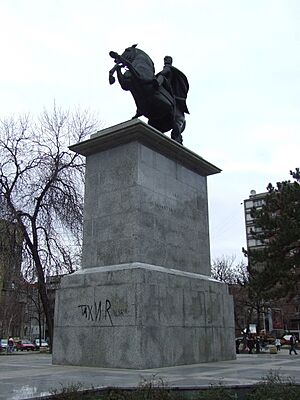
From 1929 to 1941, Niš was the capital of the Morava Banovina region within the Kingdom of Yugoslavia. A tram system started running in 1930. The national airline, Aeroput, also made Niš a regular stop.
During World War II, the first Nazi concentration camp in Yugoslavia was set up in Niš. Many people were held there. The city was heavily bombed by the Allies in 1944. Niš was liberated on October 14, 1944, by the Bulgarian Army and Partisans.
After World War II, the University of Niš was founded in 1965.
During the 1999 NATO bombing of Yugoslavia, Niš was hit by airstrikes multiple times. Sadly, 16 civilians were killed in a cluster bomb raid on May 7, 1999.
In recent years, Niš has continued to grow. A new, large Clinical Centre of Niš building opened in 2017, improving healthcare for the region.
Geography of Niš
Niš is located in the Nišava river valley, where it meets the South Morava river. The city center is about 194 meters above sea level. The highest point nearby is "Sokolov kamen" (Falcon's Rock) on Suva Planina (Dry Mountain), which is 1523 meters high. The lowest point is near the Nišava river's mouth, at 173 meters. The city covers an area of about 596.71 square kilometers.
Niš is important because of its location. Major roads from Europe and Belgrade split here: one goes south towards Thessalonica and Athens, and the other goes east towards Sofia and Istanbul.
Climate
Niš has a climate that is mostly humid subtropical, but it also has influences from a continental climate. The average temperature in Niš is about 12.4°C. July is the warmest month, with an average of 23.1°C, while January is the coldest, averaging 0.9°C. The city gets about 613.8 mm of rain each year. On average, there are 134 days with rain and snow covers the ground for about 41 days.
People of Niš (Demographics)
| Historical population of city proper | ||
|---|---|---|
| Year | Pop. | ±% |
| 1878 | 12,801 | — |
| 1884 | 16,178 | +26.4% |
| 1890 | 19,877 | +22.9% |
| 1895 | 21,524 | +8.3% |
| 1900 | 24,573 | +14.2% |
| 1905 | 21,946 | −10.7% |
| 1910 | 24,949 | +13.7% |
| 1921 | 28,625 | +14.7% |
| 1931 | 35,465 | +23.9% |
| 1941 | 44,800 | +26.3% |
| 1948 | 49,332 | +10.1% |
| 1953 | 58,656 | +18.9% |
| 1961 | 81,250 | +38.5% |
| 1971 | 127,654 | +57.1% |
| 1981 | 161,376 | +26.4% |
| 1991 | 173,250 | +7.4% |
| 2002 | 173,724 | +0.3% |
| 2011 | 183,164 | +5.4% |
| 2022 | 182,797 | −0.2% |
| Source: Становништво, национална или етничка припадност, подаци по насељима, Републички завод за статистику | ||
According to the 2022 census, the city of Niš had 182,797 residents. The wider administrative area had 260,237 people.
Most people in Niš are Serbian Orthodox Christians. There are also smaller groups of Muslims, Catholics, and Protestants. Most of the population speaks the Serbian language.
Ethnic Groups
The majority of people in Niš are Serbs. There are also significant communities of Romani people, as well as smaller groups of Bulgarians, Montenegrins, and Croats.
City Parts (Administrative Divisions)
The city of Niš is divided into five smaller areas called municipalities. Four of these are in the main urban area of Niš, and one, Niška Banja, is a suburban area.
The main neighborhoods within these municipalities include:
- Medijana: Center, Marger, Kičevo, Čair, Bulevar Nemanjića, Bulevar Djindjica, Medijana, Trošarina, Duvanište, Brzi Brod.
- Palilula: Palilula, Staro Groblje, Crni put, Bubanj, Ledena Stena, Suvi Do, Apelovac, Kovanluk, Tutunović Podrum, Kalač Brdo, Gabrovačka reka.
- Pantelej: Jagodin Mala (partly), Durlan, Komren (partly), Čalije, Somborski bulevar, Vrežina, Branko Bjegović, Podvinik, Beverli Hils.
- Crveni Krst: Crveni Krst, Beograd Mala, Jagodin Mala (partly), Komren (mostly), Šljaka, Medoševac, Ratko Jović, Stevan Sindjelić.
- Niška Banja: Niška Banja, Nikola Tesla, Jelašnica, Sićevo, Ostrovica, Prva Kutina, Radikina Bara, Prosek, Čukljenik, Donja and Gornja Studena.
Economy of Niš
Niš is a major center for business and culture in southeastern Serbia. Its location is very important because it sits at a crossroads of European highways and railways that connect Europe with Asia. Niš has an airport, Niš Constantine the Great Airport, and many roads and train lines pass through it.
The main road from northern Europe and Belgrade splits in Niš:
- One path goes south towards Thessalonica and Athens.
- The other path goes east towards Sofia and Istanbul.
These roads have been important for trade and travel since ancient times. They were known as 'Via Militaris' by the Romans and Byzantines, and later as the 'Constantinople road' in the Middle Ages. Today, they are still major European routes.
Niš used to be a very developed city in former Yugoslavia. It is known for industries like tobacco, electronics, construction, and textiles.
Key Industries and Companies
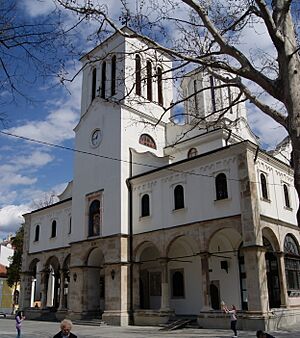
Niš is a significant industrial city in Serbia. Some of the most important companies that helped Niš grow in the past include:
- EI Niš (electronics industry)
- Mechanical Industry Niš
- Niš Tobacco Factory
- "Nitex – Niš" (textile industry)
In recent years, several international companies have opened factories in Niš, such as Integrated Micro-Electronics, Inc., Yura Corporation, Zumtobel Group, Johnson Electric, and Shinwon. A Chinese car parts manufacturer, Xingyu automotive systems, is also building a factory here.
In 2019, the companies with the highest earnings in Niš were Philip Morris International and Johnson Electric.
Transportation in Niš
Niš is a key transportation hub because of its location. It connects the Morava river valley in the north with the Vardar river valley in the south. This makes it a main route between Greece and Central Europe. The city is also linked to the Nišava river valley, which goes east towards Sofia and Istanbul.
The first highways in the area were built in the 1950s, connecting Niš with Belgrade. Today, the city is connected by the E75 highway to Belgrade and Central Europe in the north, and to Skopje, Thessaloniki, and Athens in the south. The E80 highway links Niš with Sofia, Istanbul, and the Middle East, as well as with Pristina, Montenegro, and the Adriatic Sea to the west.
Niš is also an important railway junction, connecting Serbia to Sofia and Istanbul.
The Niš Constantine the Great Airport is the second most important airport in Serbia. It started as an airfield in 1910.
Within the city, there are 13 bus lines for public transportation. The Niš Bus Station is the main hub for both local and international bus travel.
Culture in Niš
Theatre and Music
Niš is home to the National Theatre in Niš, which was founded in 1889.
Since 1981, Niš has hosted the Nišville International Jazz music festival every August. Many famous music bands from Niš include Galija, Kerber, and Eyot.
Tourism in Niš
Niš has many interesting places to visit, showing its long and rich history.
Popular Tourist Sites
- Čegar – This is where the important Battle of Čegar took place in 1809.
- Crveni Krst concentration camp – One of the few preserved Nazi concentration camps in Europe. It is located on February 12 Boulevard.
- Memorial to Constantine the Great – Built in 2013 to honor Emperor Constantine, who was born in Niš.
- Bubanj – A monument to fallen World War II fighters, shaped like three clenched fists. It marks the place where many civilians were killed during the war.
- Niš Fortress – An impressive fortification built by the Turks in the early 18th century. It's in the city center.
- Mediana – An archaeological site with remains of an Imperial villa from the Roman period, near the road to Sofia.
- Niška Banja (Niš spa) – A popular spa located about 10 kilometers from the city center, at the foot of Suva Planina Mountain.
- Tinkers Alley – An old street in the city, once full of craftsmen, now known for its cafes and restaurants.
- Skull Tower (Ćele Kula) – A unique monument built from the skulls of Serbian revolutionaries from the 1804–13 uprising. It's on Zoran Đinđić Boulevard.
Sports in Niš
Niš has many sports clubs, including the football club Radnički Niš and handball clubs like RK Železničar 1949.
The largest stadium in Niš is the Stadion Čair, which can seat 18,151 people after its renovations. This stadium is part of the Čair Sports Complex, which also has an indoor swimming pool and an indoor arena. Niš was one of the host cities for the 2012 European Men's Handball Championship.
Famous People from Niš
Many notable people were born in Niš or lived there:
- Constantine I, the Great (272–337) – Roman Emperor, born in Niš.
- Justin I (c. 450–527) – Byzantine Emperor.
- Stevan Sinđelić (died 1809) – A Serbian war leader.
- Stevan Sremac (1855–1906) – A famous Serbian writer who wrote about life in old Niš.
- Dragiša Cvetković (1893–1969) – Former Prime Minister of Yugoslavia.
- Šaban Bajramović (1936–2008) – A well-known Romani singer and composer.
- Kornelije Kovač (1942–2022) – A famous rock musician and composer.
- Goran Paskaljević (1947–2020) – A respected movie director.
- Miki Manojlović (born 1950) – A famous actor.
- Zoran Živković (born 1960) – A former Prime Minister of Serbia.
- Dragan Stojković (born 1965) – A famous football player and Olympic bronze medalist.
- Nikola Karabatić (born 1984) – A French handball player, Olympic, World, and European champion.
- Nemanja Radulović (born 1985) – A world-renowned violinist.
- Stefan Jović (born 1990) – A basketball player and Olympic silver medalist.
International Connections
Niš has diplomatic connections with other countries. After Belgrade, it has the largest number of diplomatic offices in Serbia.
Consulates in Niš
Honorary Consulates in Niš
Sister Cities
Niš is twinned with several cities around the world, meaning they have special friendly relationships:
 Kassandra, Greece
Kassandra, Greece Sparta, Greece
Sparta, Greece Glyfada, Greece
Glyfada, Greece Maroussi, Greece
Maroussi, Greece Alimos, Greece
Alimos, Greece Veliko Tarnovo, Bulgaria
Veliko Tarnovo, Bulgaria Košice, Slovakia
Košice, Slovakia Kursk, Russia
Kursk, Russia Saltdal, Norway
Saltdal, Norway Bad Homburg, Germany
Bad Homburg, Germany
Other Friendly Cities
Niš also has friendly cooperation with:
Local Media
Niš has various local media outlets, including online newspapers, radio stations, and TV channels.
- Online newspapers
- Narodne novine "Народне новине"
- Južne vesti (Southern news)
- Radio stations
- Banker radio (98.3)
- City radio (99.9)
- Radio Nišava (104.0) (in Romany)
- Radio Belle Amie (95.6)
- TV stations
- Banker TV
- BelleAmie TV
- TV Nais
- RTV Nišava (in Romany)
- NTV Media Niš
- Art TV
- Kopernikus Televizija
Images for kids
See also
 In Spanish: Niš para niños
In Spanish: Niš para niños


